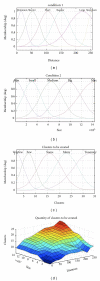Wavelet transform fuzzy algorithms for dermoscopic image segmentation
- PMID: 22567042
- PMCID: PMC3332176
- DOI: 10.1155/2012/578721
Wavelet transform fuzzy algorithms for dermoscopic image segmentation
Abstract
This paper presents a novel approach to segmentation of dermoscopic images based on wavelet transform where the approximation coefficients have been shown to be efficient in segmentation. The three novel frameworks proposed in this paper, W-FCM, W-CPSFCM, and WK-Means, have been employed in segmentation using ROC curve analysis to demonstrate sufficiently good results. The novel W-CPSFCM algorithm permits the detection of a number of clusters in automatic mode without the intervention of a specialist.
Figures







References
-
- Argenziano G, Soyer HP. Dermoscopy of pigmented skin lesions—a valuable tool for early diagnosis of melanoma. Lancet Oncology. 2001;2(7):443–449. - PubMed
-
- Vestergaard ME, Macaskill P, Holt PE, Menzies SW. Dermoscopy compared with naked eye examination for the diagnosis of primary melanoma: a meta-analysis of studies performed in a clinical setting. British Journal of Dermatology. 2008;159(3):669–676. - PubMed
-
- Argenziano G, Fabbrocini G, Carli P, de Giorgi V, Sammarco E, Delfino M. Epiluminescence microscopy for the diagnosis of doubtful melanocytic skin lesions: comparison of the ABCD rule of dermatoscopy and a new 7-point checklist based on pattern analysis. Archives of Dermatology. 1998;134(12):1563–1570. - PubMed
-
- Ascierto PA, Palmieri G, Celentano E, et al. Sensitivity and specificity of epiluminescence microscopy: evaluation on a sample of 2731 excised cutaneous pigmented lesions. British Journal of Dermatology. 2000;142(5):893–898. - PubMed
Publication types
MeSH terms
LinkOut - more resources
Full Text Sources
Medical

